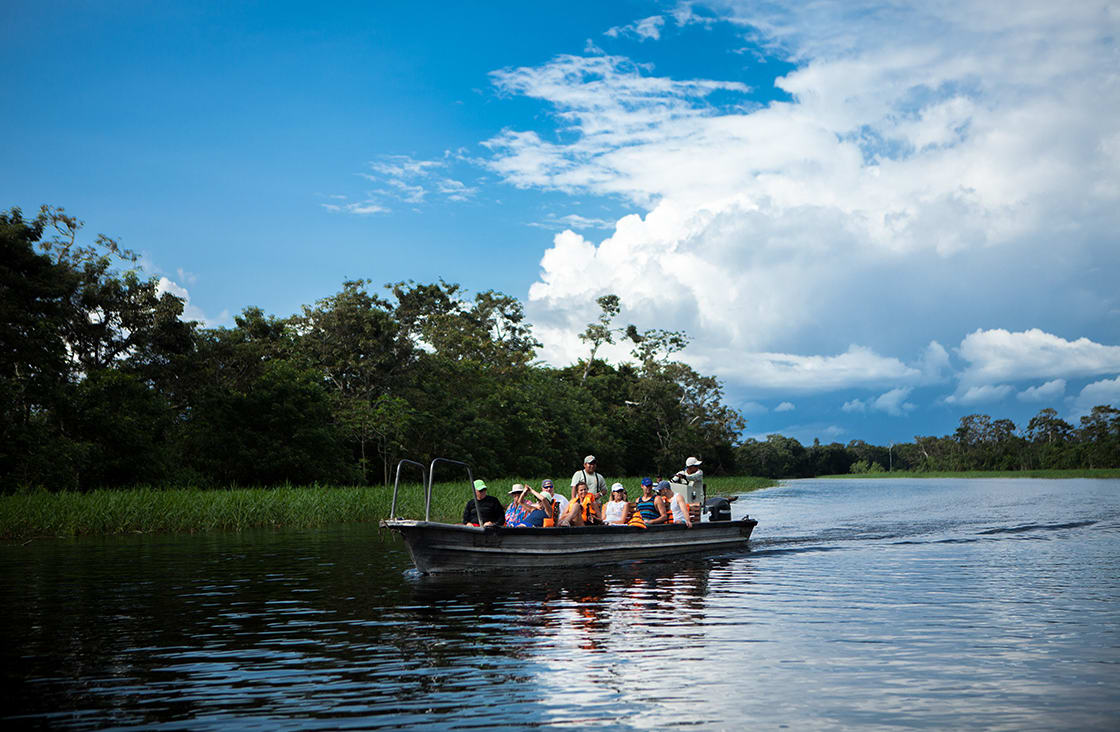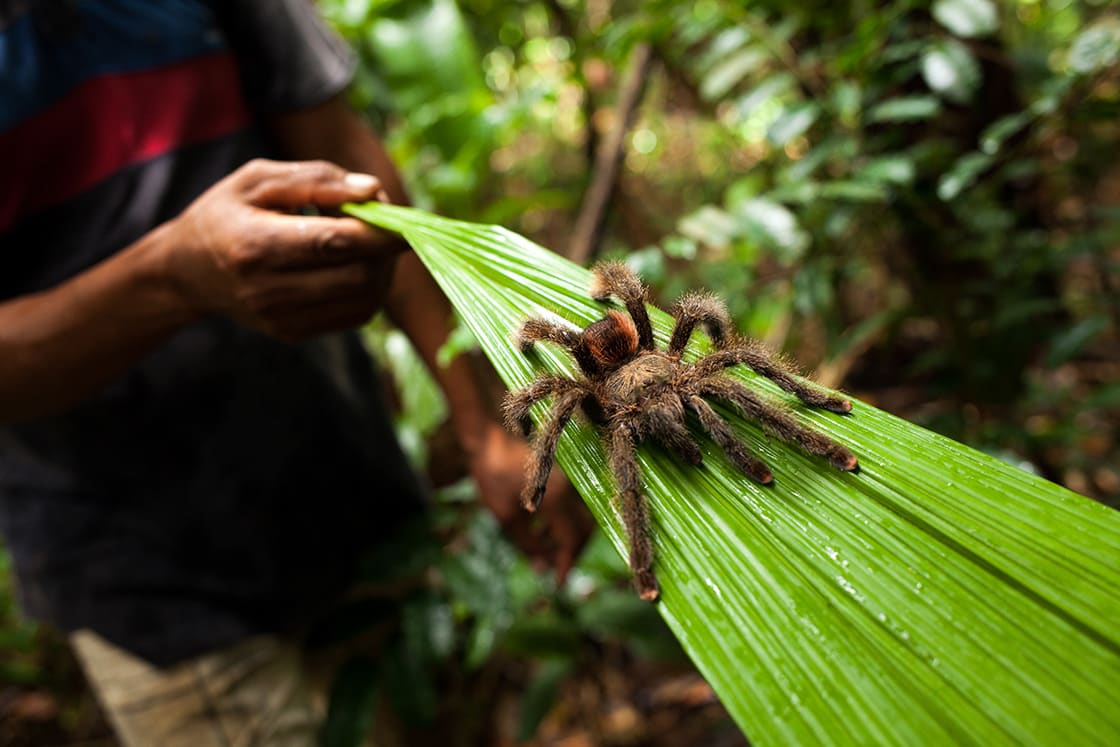
A tour of the Amazon Rainforest is a remarkable experience. There is, however, some important safety information you should know before taking an Amazon vacation.
When traveling in the Amazon there are some dangers and risks to be aware of, both natural and human, and a number of ways to protect yourself from falling victim to crime or injury. Here then is a short guide on how to stay safe in the Amazon Rainforest.
Even before you make it to the Amazon, you should consult your physician before traveling, explain where you are going and when, and seek professional advice about which tablets/medications you need (if any). Your physician will also be able to check that you are up to date with your vaccinations and advise you if you are taking any other medication.
Be aware that it is very difficult to come by medicines in the Amazon, so be sure to take all of the precautions and bring a realistic supply of medicine for your trip. If you take a regular prescription drug make sure you have enough with you, as it is unlikely that you will be able to purchase your specific drug in the Amazon.
For visitors to the Amazon, it’s often advised that you take malaria pills, you usually have to take these for a few weeks before you leave so make sure you leave enough time to get a prescription from your doctor. Check with your physician to see if you are vaccinated for yellow fever, if not then seek advice and make sure you are covered.
Be aware that some airports ask to see your vaccination certificate to prove you are covered, so make sure you bring this with you. You should also bring plenty of insect repellent with a high content of DEET (diethyl-meta-toluamide) – this will help to prevent any mosquito bites. It’s also advisable to bring along some hydrocortisone cream too, just in case you do get bitten by a nasty critter.

The Naturalist Guides are trained to identify animals and would never put anyone in danger
The main reason travelers head to the Amazon is to see its remarkable flora and fauna, and their zest for the perfect shot or encounter may lead them to temporarily forget that this is a wild realm. Always remember to respect the flora and fauna of the jungle, as many species are capable of inflicting nasty injuries, and in the worst cases can be toxic and even lethal.
But don’t fear, most Amazonian wildlife is more scared of you than you are of it, so you should try to remain calm and quiet when witnessing any creatures you come across so as not to startle it. If you provoke an animal it may react negatively to protect itself. By keeping quiet you will also increase your chances of wildlife spotting!
Our guides are trained to identify these animals and would never put anyone in danger. If you have a specific fear (say you’re afraid of snakes for example), be sure to let your guide know so they can better anticipate your reaction to any encounters. Wellington boots are provided for jungle treks and serve as great protection from plants, insects, and other critters that dwell on the ground that might bite, sting or scratch.
During an Amazon river cruise, you will almost certainly come across piranha. In fact, many cruises and lodges allow you to fish for them. There are various myths about piranhas, such as how they can devour a human body or cattle in seconds. Fortunately, these myths are quite far from the truth, and we can assure travelers that they face no significant threat from this otherwise tiny fish.
Our experienced guides communicate with one another via radio throughout any excursions in the water or through the jungle, this not only provides a location for the group to other guides but can also be used to let guides know of any potentially dangerous wildlife or terrain. What’s more, these eagle-eyed guides know exactly how to spot dangerous situations and how to avoid them.

Most Amazon riverboats have first aid + CPR trained staff on board
All riverboats undergo checks and regulated dry-dock periods for maintenance, to ensure every boat is safe and secure for passengers. Most Amazon riverboats have first aid + CPR trained staff on board, as well as health professionals who help in the local villages, with first aid supplies on every boat. Before you begin a cruise there will be a safety briefing for all guests, to ensure everyone understands the safety procedures when onboard the boat. After which you can ask questions of our expert crew and guides if you have any further concerns.
On all cruises, there are trained professionals who have lived and worked in the region for most of their life. These crew members know the ins and outs of the jungle and the locations you’ll visit, there’s nothing they won’t be able to answer or help with. With their in-depth knowledge of the seasons and river conditions, our guides and crew understand how to adapt activities and itineraries to ensure they are entirely safe to do, especially if there is a sudden weather change. For example, if there is excessive flooding that prevents a hiking activity the crew will adjust the schedule accordingly or change the activity if need be.
The large Amazon River is constantly moving and changing course, and so captains of Amazon riverboats have been specially trained and operate with specific licenses on the river. They are highly skilled and knowledgeable about the river, but also use high-tech equipment such as GPS and sonar in case of an emergency. Captains follow strict Amazon River speed limits for all of the boats they operate on the river. For a large vessel, the speed limit is up to 30 knots per hour and for skiff boats, used for excursions, boats can reach no more than 10 knots per hour. In case of emergency, crews are equipped with emergency flares and signals, as well as VHF and UHF radios. If a serious evacuation is required, floatplanes and speedboats will be used to abandon the vessel.
Every riverboat contains the following safety equipment:
Some boats may also have armed guards on board, whether dressed in uniform or in civilian clothes. This is in reaction to two historical incidents that took place when armed bandits stormed a vessel and robbed passengers on board. As a result of this cruise companies and the local marine authorities have increased their security measures as a deterrent. All cruise companies have different security procedures and personnel, which are always changing. If you have concerns about a particular vessel, ask us for updated information.
On rare occasions, passengers may suffer from motion sickness, although this isn’t usually an issue, as the riverboats move very slowly and calmly through the waters of the Amazon – however, if you do suffer from motion sickness or have experienced it before, then it’s best to be prepared and bring along some gravol just in case. Symptoms include nausea, vomiting, and dizziness, but our boats allow you to get some fresh Amazon air from the deck, which will usually help clear up any mild cases of motion sickness.

Tourist In a Handicraft Market In the Pacaya SAmiria Reserve
South American people are renowned for being extremely friendly and hospitable, in fact, many of its countries have been consistently voted in the top ten friendliest countries in the world. Despite this, like anywhere, crime can be an issue in some of the bigger cities and towns. You can help yourself by wearing modest clothing, without showing off any expensive jewelry or cell phones, and also by being aware of your surroundings. If you are carrying a backpack around a city or town make sure you are aware of it at all times and make sure it is shut. If you can try to avoid keeping your valuables in your backpack, too.
It’s best to keep cash and important documents, such as your ID and/or passport, in a zipped location that is always in your sight. Ideally, valuables should be kept in a body wallet that can be strapped beneath your clothes, or in a purse that has a zipper and can be secured across your body. You can also lock away your valuables in one of our safety deposit boxes onboard our luxury boats.
If you are surrounded by lots of people and someone attempts to distract you by telling you that something is on your bag or by spraying something on you, be very aware of your belongings. Thieves in cities often work together and while one works to distract you, the others are already stealing from you. In this situation, it’s best to walk away quickly until you reach somewhere safe to stop.
If you need to take a taxi in a city in South America be careful about calling a taxi on the street. It’s much safer to ask the hotel or restaurant you are in to call you a “safe taxi” instead. If you aren’t near a hotel or restaurant that you feel comfortable with, then use internationally known taxi companies, such as Uber, Easy Taxi, or Cabify, to call a taxi. Download the app in advance from your hotel room, and order the taxi from your smartphone. These clever apps with pop up with the face and license plate of your driver to ensure you get into the right car.
For additional tips, perhaps some of the most important lessons on safety (and survival) in the Amazon can be found from tales of jungle tragedy from survivors such as Juliane Koepcke. Alternatively, if you need any further information or have any questions about Amazon Rainforest safety then do not hesitate to contact us.
While Rainforest Cruises aim to provide accurate and up-to-date information, we make no representations as to the accuracy or completeness of any information herein or found by following any link on this site. Rainforest Cruises cannot and will not accept responsibility for any omissions or inaccuracies, or for any consequences arising therefrom, including any losses, injuries, or damages resulting from the display or use of this information.




